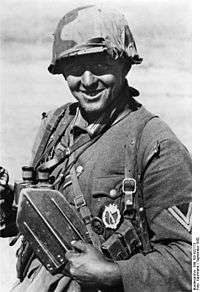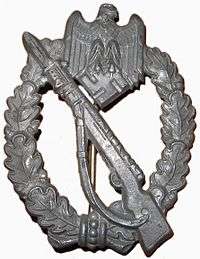Infantry Assault Badge
| Infantry Assault Badge Infanterie-Sturmabzeichen | |
|---|---|
|
Infantry Assault Badge in Silver. | |
| Awarded by Nazi Germany | |
| Type | Badge |
| Eligibility | Military personnel |
| Awarded for | Silver grade awarded to non-motorized infantry and mountain personnel who participated in combat action and bronze grade was meant for motorized infantry troops. |
| Campaign | World War II |
| Status | Obsolete |
| Statistics | |
| Established |
20 December 1939 (Silver grade) 1 June 1940 (Bronze grade). |
 An infantry soldier wearing the Infantry Assault Badge in Silver during in September 1942, during the Battle of Stalingrad. | |
The Infantry Assault Badge (German: Infanterie-Sturmabzeichen) was a German war badge awarded to Waffen SS and Wehrmacht Heer soldiers during the Second World War. This decoration was instituted on 20 December 1939 by the Commander-in-Chief of the German Army, Generalfeldmarschall Walther von Brauchitsch. It could be awarded to members of non-motorized Infantry units and units of the Gebirgsjäger that had participated in Infantry assaults, with light Infantry weapons, on at least three days of battle in the front line on or after 1 January 1940. When a counter offensive led to fighting, it could also apply. Award of the Infantry Assault Badge was authorized at regimental command level.[1]
Classes
Silver
The silver class was instituted on 20 December 1939 by the commander of the OKH, Walther von Brauchitsch, and was awarded to infantry soldiers according to one of the following criteria:[2]
- To have taken part in at least three: infantry assaults (including counter-attacks) or at least three armed reconnaissance operations or engaged in hand-to-hand combat in an assault position or participated on three separate days in the restitution of combat positions.
Bronze
The bronze class was instituted on 1 June 1940. It was awarded to motorized/Mechanized Infantry troops according the same criteria as listed above.[3]
Design
The badge was designed by the company C. E. Junker of Berlin. It is oval in shape, with four oak leaves on each side; on the top is a national eagle clutching a swastika and a rifle with a fixed bayonet across the badge. The reverse of the badge is plain and has a pin attached to it.[3] The original "silver" badges were made of silver-plate and the later ones were made of zinc. The "bronze" version was actually made of a "metal alloy".[3]
With the institution of the Ordensgesetz of 1957, German military personnel were permitted to wear de-nazified versions of German decorations. Also the badge was produced from 1957 as a de-nazified version in "silver" and "bronze", without the eagle clutching a swastika.
Notes
- ↑ Angolia 1987, pp. 80, 81.
- ↑ Angolia 1987, p. 80.
- 1 2 3 Angolia 1987, p. 81.
References
- Angolia, John (1987). For Führer and Fatherland: Military Awards of the Third Reich. R. James Bender Publishing. ISBN 0912138149.
